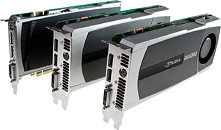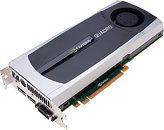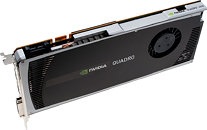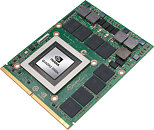Tuesday, July 27th 2010

New NVIDIA Fermi-Class Quadro Launches the Era of Computational Visualization
NVIDIA today launched the era of the 'computational visualization workstation' for designers, engineers, researchers and animators by introducing its Quadro graphics processing units (GPUs) based on NVIDIA Fermi architecture, and by also introducing the new NVIDIA 3D Vision Pro solution. The new Quadro GPUs deliver performance that is up to five times faster for 3D applications and up to eight times faster for computational simulation, shattering previous benchmarks.
The NVIDIA Quadro Plex 7000 array, and Quadro 6000, Quadro 5000 and Quadro 4000 GPUs feature the new NVIDIA Scalable Geometry Engines and leverage NVIDIA Application Acceleration Engines (AXE) to enable the world's fastest performance across a broad range of CAD, DCC and visualization applications. Rated at an unheard of 1.3 billion triangles per second in raw performance, the Quadro 6000 enables users to interactively work with models and scenes that are five times more complex than ever before."For over a decade Quadro has been the choice of professionals around the world. We've also built Engines like AXE to enable the creation of next-gen applications," said Jeff Brown, general manager, Professional Solutions Group, NVIDIA. "When you couple these technologies with our Fermi architecture, the result is a new Quadro family that's exponentially better than anything the market has ever seen."
Redesigned from the Ground Up to Accelerate Entire Workflows
Combining high performance computing capabilities with advanced visualization, the new Quadro GPU is the world's first professional graphics solution with Error Correction Codes (ECC) memory and fast, IEEE double precision floating point performance. These are intended for applications demanding the highest accuracy, such as medical imaging, finite element analysis and computational fluid dynamics.
"In high-end visual effects development, fast iteration is essential," said Olivier Maury, research and development engineer, Industrial Light & Magic (ILM). "By using NVIDIA Quadro GPUs, we are seeing up to eight iterations each day of complex fire, dust and air simulations, representing speed improvements of ten to fifteen times. NVIDIA CUDA and Quadro GPUs have entirely changed the way we solve complex visual effects challenges."
The new Quadro GPUs are built on industry standards, including OpenGL 4.1, DirectX 11, DirectCompute and OpenCL. In addition, Quadro leverages technologies that are unique to NVIDIA -- such as the company's portfolio of Application Acceleration Engines (AXE) and NVIDIA CUDA parallel processing architecture. The result is that software developers are able to create and deliver the next-generation of professional applications that incorporate compute-intensive tasks. Among these tasks are ray tracing, physics simulation, computational fluid dynamics and real-time video effects processing.
"NVIDIA isn't just working on building better graphics hardware, but the software tools needed to drive the needed advancements that are now changing the industry," said Rob Enderle, principal analyst, Enderle Group. "NVIDIA was committed to building tool after tool this past decade in order to drive the market where they needed it to go, and their efforts are paying off."
The new Quadro professional solutions introduced today include:
-Scalable Visualization Systems:
Widespread Adoption
Workstation OEMs and System Integrators, including Dell, HP, Lenovo, BOXX Technologies and NextComputing, are among those that are offering the newest Quadro solutions. Quadro products are also available from value added resellers through master distributors PNY Technologies in North America and Europe, Leadtek in Asia Pacific, and ELSA in Japan.
"As the first professional-class GPUs to integrate high performance computing with advanced visualization, NVIDIA Quadro combined with Dell Precision workstations are poised to transform workflows," said Greg Weir, senior manager, Dell Precision Workstations Product and ISV Marketing. "With this technology, we are enabling our design, research, animation and film customers to deliver higher quality results in less time."
"NVIDIA continues to push the envelope on delivering cutting-edge graphics solutions,"said Rob Herman, director of product marketing, worldwide ThinkStation Business Unit, Lenovo. We're actively incorporating these latest graphics into our newly upgraded ThinkStation C20 and D20 workstations to deliver innovative, 'visual supercomputers' to our customers."
Availability and Pricing
The Quadro 4000 ($1,199 MSRP, USD) and Quadro 5000 ($2,249 MSRP, USD) are available immediately through all channels. The Quadro 6000 ($4,999 MSRP, USD) and Quadro Plex 7000 ($14,500 MSRP, USD) will be available this fall. Mobile workstations based on the Quadro 5000M will be available in the third quarter of 2010 from HP and Dell.
The NVIDIA Quadro Plex 7000 array, and Quadro 6000, Quadro 5000 and Quadro 4000 GPUs feature the new NVIDIA Scalable Geometry Engines and leverage NVIDIA Application Acceleration Engines (AXE) to enable the world's fastest performance across a broad range of CAD, DCC and visualization applications. Rated at an unheard of 1.3 billion triangles per second in raw performance, the Quadro 6000 enables users to interactively work with models and scenes that are five times more complex than ever before."For over a decade Quadro has been the choice of professionals around the world. We've also built Engines like AXE to enable the creation of next-gen applications," said Jeff Brown, general manager, Professional Solutions Group, NVIDIA. "When you couple these technologies with our Fermi architecture, the result is a new Quadro family that's exponentially better than anything the market has ever seen."
Redesigned from the Ground Up to Accelerate Entire Workflows
Combining high performance computing capabilities with advanced visualization, the new Quadro GPU is the world's first professional graphics solution with Error Correction Codes (ECC) memory and fast, IEEE double precision floating point performance. These are intended for applications demanding the highest accuracy, such as medical imaging, finite element analysis and computational fluid dynamics.
"In high-end visual effects development, fast iteration is essential," said Olivier Maury, research and development engineer, Industrial Light & Magic (ILM). "By using NVIDIA Quadro GPUs, we are seeing up to eight iterations each day of complex fire, dust and air simulations, representing speed improvements of ten to fifteen times. NVIDIA CUDA and Quadro GPUs have entirely changed the way we solve complex visual effects challenges."
The new Quadro GPUs are built on industry standards, including OpenGL 4.1, DirectX 11, DirectCompute and OpenCL. In addition, Quadro leverages technologies that are unique to NVIDIA -- such as the company's portfolio of Application Acceleration Engines (AXE) and NVIDIA CUDA parallel processing architecture. The result is that software developers are able to create and deliver the next-generation of professional applications that incorporate compute-intensive tasks. Among these tasks are ray tracing, physics simulation, computational fluid dynamics and real-time video effects processing.
"NVIDIA isn't just working on building better graphics hardware, but the software tools needed to drive the needed advancements that are now changing the industry," said Rob Enderle, principal analyst, Enderle Group. "NVIDIA was committed to building tool after tool this past decade in order to drive the market where they needed it to go, and their efforts are paying off."
The new Quadro professional solutions introduced today include:
-Scalable Visualization Systems:
- Quadro Plex 7000, with 12 GB (total) of memory and 896 CUDA cores
- Quadro 6000, with 6 GB of GDDR5 memory and 448 CUDA cores
- Quadro 5000, with 2.5 GB of GDDR5 memory and 352 CUDA cores
- Quadro 4000, with 2 GB of GDDR5 memory and 256 CUDA cores
- Quadro 5000M, mobile workstation GPU with 2 GB of GDDR5 memory and 320 CUDA cores
Widespread Adoption
Workstation OEMs and System Integrators, including Dell, HP, Lenovo, BOXX Technologies and NextComputing, are among those that are offering the newest Quadro solutions. Quadro products are also available from value added resellers through master distributors PNY Technologies in North America and Europe, Leadtek in Asia Pacific, and ELSA in Japan.
"As the first professional-class GPUs to integrate high performance computing with advanced visualization, NVIDIA Quadro combined with Dell Precision workstations are poised to transform workflows," said Greg Weir, senior manager, Dell Precision Workstations Product and ISV Marketing. "With this technology, we are enabling our design, research, animation and film customers to deliver higher quality results in less time."
"NVIDIA continues to push the envelope on delivering cutting-edge graphics solutions,"said Rob Herman, director of product marketing, worldwide ThinkStation Business Unit, Lenovo. We're actively incorporating these latest graphics into our newly upgraded ThinkStation C20 and D20 workstations to deliver innovative, 'visual supercomputers' to our customers."
Availability and Pricing
The Quadro 4000 ($1,199 MSRP, USD) and Quadro 5000 ($2,249 MSRP, USD) are available immediately through all channels. The Quadro 6000 ($4,999 MSRP, USD) and Quadro Plex 7000 ($14,500 MSRP, USD) will be available this fall. Mobile workstations based on the Quadro 5000M will be available in the third quarter of 2010 from HP and Dell.




51 Comments on New NVIDIA Fermi-Class Quadro Launches the Era of Computational Visualization
Holy smokes!
xD
But on a serious note how would these perform when running games?
Not bad on the Plex. When nVidia first introduced the Plex series they were $20K and $25K.
Man thats a lot of cash.:eek:
bigg ass overkill xd
and to expensive and useless
And for the single-slot Q4000 (single 6-pin):
The heatsinks on the reverse side cool the memory chips there.
i think the Quadro cards look waaay better than the gtx-xxx cards
They are not made to fast process graphics and games, they are made to produce highly detailed 3D models in big resolution screens. To view and make 3D CAD models or test CFD models, it doesn't take a 1GHz core GPU, but it takes a heck of a core architecture and ability to calculate tons of polygons and tons of RAM to display them.
I admire the fact that they can go SLI.
Engineer 1 - "Oh, my Airbus A380 3D model is taking quite a while to load!"
Engineer 2 - "Just slap on another 7000 and be done with it!"
I also would like the backside RAM cooler to be included in standard cards. That would be a nice feature in cards w/RAM on the back of the card.
It comes in desktop and rack-mount form factors.
www.xbitlabs.com/news/video/display/20070502085641.html
Besides, these are NOT consumer graphics cards. They are meant for workstations and have specialized drivers that make them good at what they are intended to do, and crap at gaming.